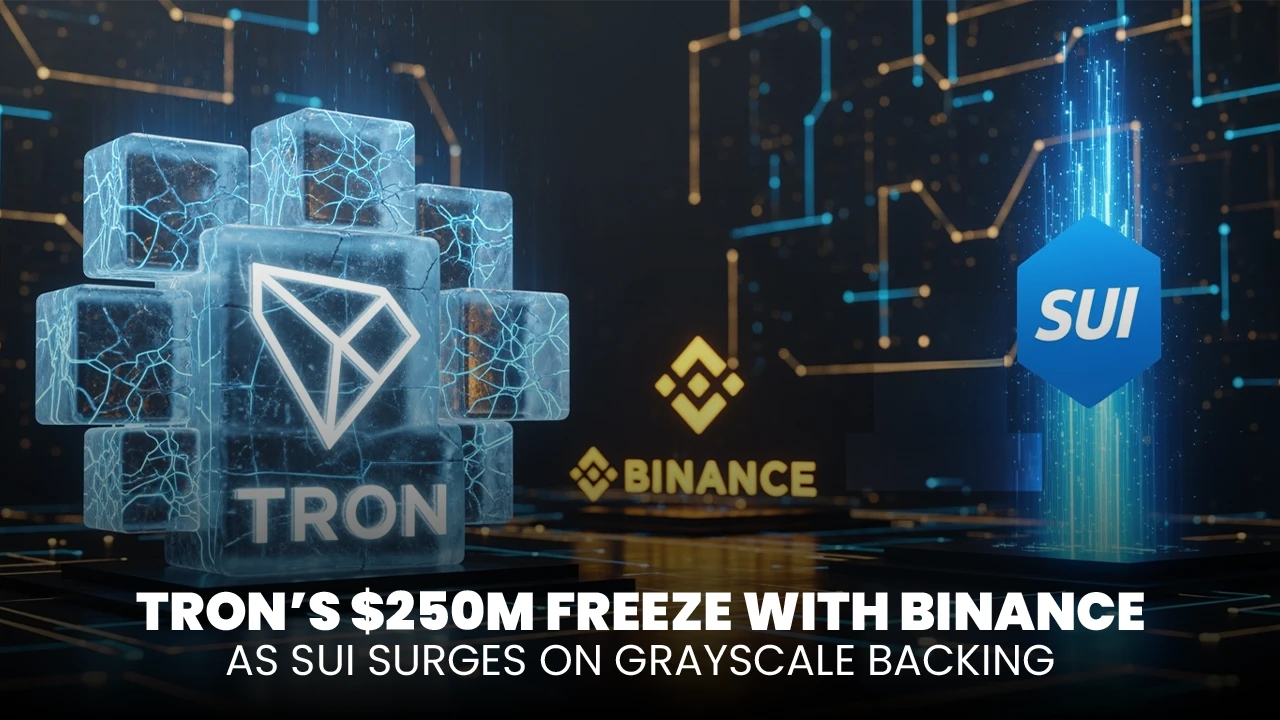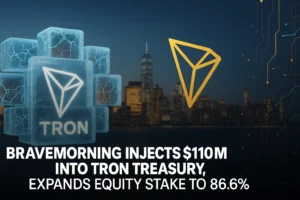Tron Escalates War on Financial Crimes with Binance, Freezes $250M Illicit Assets, as SUI Aims for Mass Adoption

TRON has taken center stage in a high-stakes initiative aimed at protecting the cryptocurrency industry from escalating financial crime. The blockchain network, which operates on a Delegated Proof of Stake (DPoS) model, is a founding member of the T3 Financial Crime Unit alongside Tether and analytics firm TRM Labs. The alliance, launched in September 2024, has already frozen more than $250 million worth of illicit assets.
In August, the effort expanded into a broader collaboration known as T3+, welcoming Binance into the fold. The exchange quickly proved its value by helping seize nearly $6 million tied to a cross-border “pig butchering” scam.
The rapid response showed how pooling intelligence across multiple platforms can make a tangible difference in stopping criminals who increasingly exploit the speed and scale of digital asset markets.
The urgency is clear. In the first half of 2025 alone, hackers stole more than $3 billion worth of crypto. Laundering operations now move funds in as little as three minutes, according to TRM Labs, leaving exchanges with only a few minutes to act before money vanishes into untraceable channels.
Recovery rates remain low, with just 4.2 percent of stolen funds retrieved in that period. By combining TRON’s DPoS network transparency with intelligence sharing from major players, T3+ aims to improve these odds.
Why TRON’s Role Matters
TRON is one of the most widely used blockchains in the world, especially for stablecoin activity. With more than $50 billion in Tether circulating on its rails, any vulnerability in Tron’s network would ripple across global markets.
Its Delegated Proof of Stake architecture allows for quick block validation through elected super representatives, which supports fast transactions but also demands high accountability from validators.
That design makes TRON a natural fit for initiatives like T3+. The network is already used for transferring billions of dollars every day, and its involvement guarantees the availability of real-time streams of the most popular assets used in crypto to the crime unit.
Even to regulators and market stakeholders, such collaboration implies that blockchain operators will no longer be satisfied to sit and watch as criminal elements take advantage of their systems.
ALSO READ: TRON Pulls $9.9B in USDT Out of Ethereum as Stablecoin Shift Gains Momentum
SUI Surges on Robinhood Rumors
While TRON was making headlines for its institutional push against crime, SUI captured attention on the retail side. The Layer 1 blockchain’s token surged to $3.74 after a blog post hinted at an imminent listing on Robinhood.
Although the post was quickly deleted, the market reaction was swift, showing just how much weight the trading app still carries with retail investors in the United States. SUI’s rally highlighted the hunger for new assets on mainstream platforms. The token has seen its total value locked climb toward $2 billion this summer, driven by activity in decentralized finance applications.
Even with open interest slipping from $1.34 billion in July to $931 million in August, more than three-quarters of positions remain long, suggesting traders expect continued momentum.
🆕👀 #SUI Robinhood listed $SUI#crypto
— CryptOpus (@ImCryptOpus) August 12, 2025
The rumor placed SUI firmly in the spotlight, bridging the gap between early-stage blockchain adoption and broader retail access.
Institutional Backing for SUI
The Robinhood speculation was not the only driver behind SUI’s growing profile. Grayscale, the world’s largest digital asset manager, recently launched new trusts linked to SUI’s core protocols DeepBook and Walrus.
DeepBook functions as an on-chain order book that has already processed more than $10 billion in trades, while Walrus provides programmable data storage and has secured $140 million in funding.
Grayscale is introducing institutional credibility to the ecosystem of SUI by developing trust products for accredited investors. That move follows a familiar script: retail speculation is followed by structured investment vehicles opening the door to wider institutional involvement.
These forces have been in play, and that is what enables other Layer 1 tokens, like Solana, to evolve from niche experiments into widely traded assets.
ALSO READ: Grayscale Fuels SUI and Cardano Boom as Binance Launches Offensive on Crypto Crime
Linking the Narratives: Security and Growth
At first glance, TRON’s crime-fighting initiative and SUI’s retail-driven surge may seem like unrelated stories. Yet they are two sides of the same coin.
For crypto markets to grow, they must become safer for institutions while remaining attractive to retail users. TRON’s work with T3+ strengthens the guardrails, while SUI’s potential entry onto Robinhood lowers the barriers to entry for new investors.
The technical underpinnings matter here as well. Delegated Proof of Stake has long been touted for its ability to handle large volumes of transactions with lower energy consumption. In Tron’s case, that scalability makes it the backbone for stablecoin transfers and crime-fighting oversight.
In SUI’s case, its unique consensus architecture delivers sub-second finality that retail platforms like Robinhood require to provide seamless trading experiences. Both networks show how design choices can directly impact market adoption.
Key Metrics for TRON and SUI
| Metric | TRON | SUI |
| Consensus Model | Delegated Proof of Stake (DPoS) | Byzantine Consistent Engine |
| Key Initiative | T3+ crime-fighting alliance | Robinhood listing rumors, Grayscale trusts |
| Assets Frozen / TVL | $250M frozen via T3 FCU | ~$2B Total Value Locked |
| Major Backer / Partner | Tether, TRM Labs, Binance | Grayscale Trust Products |
| User Market Impact | Stablecoin transfer dominance | Token rally to $3.74 on rumors |
The Wider Market Context
The developments have emerged when the cryptocurrency market is rediscovering its priorities. Security flaws have proven extremely costly in the year 2025 as hackers have exploited all the vulnerabilities in the protocols of the bridge and centralized wallets.
Meanwhile, the number of institutional inflows is rising with the expansion of companies such as Grayscale and BlackRock in their product offerings.
Retail participation remains volatile but powerful. The SUI rally demonstrated that even the suggestion of a Robinhood listing can trigger outsized moves. Similar patterns have been seen with other assets, where accessibility on mainstream trading platforms drives sudden inflows from new investors.
ALSO READ: ARK Invest Acquires $172M as Bullish Jumps 83.8% on NYSE Debut
Combined, the crime-fighting effort of TRON and the adoption achievements of SUI portray that the two extremes on the continuum, regulatory trust and retail accessibility, play an essential role in the next level of industry growth.
Conclusion
TRON and SUI dominated crypto news for very different reasons, but both stories reinforce the industry’s direction. TRON, leveraging its Delegated Proof of Stake foundation, is proving that blockchain networks can play an active role in fighting crime through alliances like T3+.
SUI, meanwhile, has captured the imagination of traders through rumors of a Robinhood listing and won over institutions with Grayscale trust products. Their combined narratives show that for crypto to thrive, it must be both secure and accessible. By pairing strong compliance frameworks with opportunities for retail participation, these projects are setting a template for how digital assets can mature into mainstream finance.
Frequently Asked Questions (FAQs)
- What is TRON’s role in the T3+ initiative?
TRON co-founded the T3 crime unit and remains central to its expansion, helping freeze more than $250 million in illicit crypto. - Why is SUI gaining attention now?
A mistakenly published blog suggested an upcoming Robinhood listing, and Grayscale has launched new institutional trusts tied to SUI. - How does Delegated Proof of Stake affect TRON?
It allows for faster, more scalable transactions while holding elected validators accountable, which aligns with its role in monitoring flows. - How much crypto has been stolen in 2025 so far?
More than $3 billion was stolen in the first half of the year, underscoring the need for rapid security collaborations like T3+. - What does a Robinhood listing mean for SUI?
It would make SUI accessible to millions of U.S. retail traders, potentially expanding its user base and liquidity.
Glossary of Key Terms
- Delegated Proof of Stake (DPoS): A consensus model where token holders vote for delegates to validate transactions and secure the network.
- T3 Financial Crime Unit (T3 FCU): An alliance formed by TRX, Tether, and TRM Labs to freeze illicit crypto assets.
- T3+: The expanded version of T3 FCU that includes Binance and other exchanges for intelligence sharing.
- Total Value Locked (TVL): The total value of assets locked in a decentralized protocol.
- Open Interest: The total value of outstanding futures contracts in a market.
- Layer 1 Blockchain: A standalone blockchain that validates and processes transactions without relying on another network.




